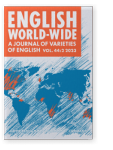Vol. 44:2 (2023) ► pp.184–218
Grammatical variation in World Englishes
An onomasiological study
This study adopts an onomasiological, alternation-based approach to the exploration of grammatical variation across World Englishes, using data sourced from the 1.9 billion-word Global Web-based English corpus. The macro-orientation of the study, which investigates a set of ten alternations known to be susceptible to diachronic change, facilitates identification of a number of general trends, including the typical advancement of the Inner Circle varieties and of the South-East Asian varieties, the hypercentrality of American English, and the epicentrality of Indian English in South Asia. Possible explanatory factors include colloquialisation, grammatical simplicity/complexity, developmental status, and areal proximity.
Article outline
- 1.Introduction
- 2.Data and methodology
- 3.Explanatory considerations
- 4.Findings
- 4.1Perfect aspect
- 4.2Progressive aspect
- 4.3Passive voice
- 4.4Subjunctive mood
- 4.4.1The subjunctive mandative
- 4.4.2The subjunctive-were conditional
- 4.5Non-finite complementation
- 4.5.1 Prevent NP (from) Ving
- 4.5.2 Help NP (to) V
- 4.5.3 Start Ving vs start to V
- 4.6Concord with collective nouns
- 4.7First person inclusive imperatives
- 5.Discussion of findings
- 6.Conclusion
- Notes
-
References
